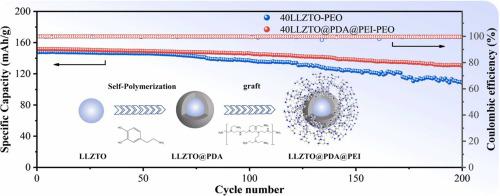当前位置:
X-MOL 学术
›
J. Alloys Compd.
›
论文详情
Our official English website, www.x-mol.net, welcomes your feedback! (Note: you will need to create a separate account there.)
The interface modification with polyethyleneimine enhances both ionic conductivity and interfacial compatibility of composite solid electrolyte
Journal of Alloys and Compounds ( IF 6.2 ) Pub Date : 2024-04-09 , DOI: 10.1016/j.jallcom.2024.174460 Huan Zhao , Xiaobao Zhang , Ning Wang , Yiyang Xiao , Shiang Liang , Weidong Zhuang , Juanyu Yang , Xiaowei Huang
Journal of Alloys and Compounds ( IF 6.2 ) Pub Date : 2024-04-09 , DOI: 10.1016/j.jallcom.2024.174460 Huan Zhao , Xiaobao Zhang , Ning Wang , Yiyang Xiao , Shiang Liang , Weidong Zhuang , Juanyu Yang , Xiaowei Huang

|
The composite solid electrolyte (CSE), polyethylene oxide (PEO)-LiLaZrTaO (LLZTO), is deemed a promising candidate for all-solid-state batteries. Nevertheless, due to the poor interfacial compatibility between LLZTO nanoparticles and PEO, achieving a homogeneous dispersion of LLZTO nanoparticles within PEO is not readily attainable. The aggregation of LLZTO within PEO leads to a decline in the ionic conductivity of the CSE and poor interface stability with the electrode, ultimately resulting in deteriorated battery cyclic performance. In this work, the interface between LLZTO and PEO is designed and comprehensively investigated. Initially, dopamine self-polymerization is employed to form a uniform coating layer on the surface of LLZTO nanoparticles. Subsequently, by utilizing the amino groups present in polyethyleneimine (PEI), which can react with the phenolic hydroxyl groups of dopamine and the ether linkages in PEO, PEI serves as a bridging agent, enhancing the interfacial compatibility between LLZTO and PEO. Here it is shown that, the ionic conductivity of the LLZTO-PEO CSE containing 40 wt% modified LLZTO increases from 6.14✕10 S cm to 1.89✕10 S cm. Furthermore, this CSE exhibits improved thermal stability, an enlarged electrochemical window of 4.8 V, a lithium-ion transference number of 0.45, and excellent interface stability with the lithium anode. The assembled LiFePO | 40 wt% LLZTO@PDA@PEI-PEO CSE | Li all-solid-state battery demonstrates an initial discharge specific capacity of 151.8 mA h g at 0.2 C, with a capacity retention of 85.8% after 200 cycles. This work provides a novel strategy for interface-modified polymer- inorganic composite solid electrolytes, which will advance the development of high-energy-density all-solid-state lithium batteries.
中文翻译:

聚乙烯亚胺的界面改性提高了复合固体电解质的离子电导率和界面相容性
复合固体电解质(CSE)、聚环氧乙烷(PEO)-LiLaZrTaO(LLZTO)被认为是全固态电池的有前途的候选者。然而,由于LLZTO纳米颗粒和PEO之间的界面相容性差,实现LLZTO纳米颗粒在PEO中的均匀分散并不容易。 PEO中LLZTO的聚集导致CSE的离子电导率下降以及与电极的界面稳定性差,最终导致电池循环性能恶化。在这项工作中,设计并全面研究了 LLZTO 和 PEO 之间的界面。最初,采用多巴胺自聚合在LLZTO纳米颗粒表面形成均匀的涂层。随后,利用聚乙烯亚胺(PEI)中存在的氨基,其可以与多巴胺的酚羟基和PEO中的醚键发生反应,PEI充当桥联剂,增强LLZTO和PEO之间的界面相容性。结果表明,含有 40 wt% 改性 LLZTO 的 LLZTO-PEO CSE 的离子电导率从 6.14×10 S cm 增加到 1.89×10 S cm。此外,该 CSE 还表现出更高的热稳定性、4.8 V 的电化学窗口、0.45 的锂离子迁移数以及与锂阳极优异的界面稳定性。组装好的磷酸铁锂 | 40 wt% LLZTO@PDA@PEI-PEO CSE | 40 wt% LLZTO@PDA@PEI-PEO CSE锂全固态电池在0.2 C下的首次放电比容量为151.8 mA hg,200次循环后容量保持率为85.8%。这项工作为界面改性聚合物-无机复合固体电解质提供了一种新颖的策略,将推动高能量密度全固态锂电池的发展。
更新日期:2024-04-09
中文翻译:

聚乙烯亚胺的界面改性提高了复合固体电解质的离子电导率和界面相容性
复合固体电解质(CSE)、聚环氧乙烷(PEO)-LiLaZrTaO(LLZTO)被认为是全固态电池的有前途的候选者。然而,由于LLZTO纳米颗粒和PEO之间的界面相容性差,实现LLZTO纳米颗粒在PEO中的均匀分散并不容易。 PEO中LLZTO的聚集导致CSE的离子电导率下降以及与电极的界面稳定性差,最终导致电池循环性能恶化。在这项工作中,设计并全面研究了 LLZTO 和 PEO 之间的界面。最初,采用多巴胺自聚合在LLZTO纳米颗粒表面形成均匀的涂层。随后,利用聚乙烯亚胺(PEI)中存在的氨基,其可以与多巴胺的酚羟基和PEO中的醚键发生反应,PEI充当桥联剂,增强LLZTO和PEO之间的界面相容性。结果表明,含有 40 wt% 改性 LLZTO 的 LLZTO-PEO CSE 的离子电导率从 6.14×10 S cm 增加到 1.89×10 S cm。此外,该 CSE 还表现出更高的热稳定性、4.8 V 的电化学窗口、0.45 的锂离子迁移数以及与锂阳极优异的界面稳定性。组装好的磷酸铁锂 | 40 wt% LLZTO@PDA@PEI-PEO CSE | 40 wt% LLZTO@PDA@PEI-PEO CSE锂全固态电池在0.2 C下的首次放电比容量为151.8 mA hg,200次循环后容量保持率为85.8%。这项工作为界面改性聚合物-无机复合固体电解质提供了一种新颖的策略,将推动高能量密度全固态锂电池的发展。



























 京公网安备 11010802027423号
京公网安备 11010802027423号